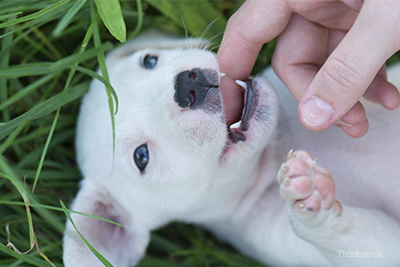Now that you have a new puppy you will be continually amazed by the changes that present themselves developmentally and physically every day. Your new puppy is not yet fully developed and, in fact, development will continue for the next several months. Some changes will be obvious such as size, hair-coat and behavior; others, like maturing and changing teeth will be less apparent.
 When will your dog’s teeth change?
When will your dog’s teeth change?
Although the timelines of development are different between people and puppies, the changes that occur in dental development are very parallel. As with children, baby dogs are born with no erupted teeth. This allows for easier nursing and less discomfort for the nursing mother. “Baby teeth,” called deciduous teeth by veterinarians, develop and erupt in the first few months. They allow young dogs to begin eating solid foods. Over the next few months the deciduous teeth are gradually replaced by adult teeth so the dog can eat a more substantial food.
What could go wrong with your dog’s baby teeth?
The development of teeth in a young dog is a process and there are a number of stages where things may progress normally or may go wrong and result in abnormal dental development. Dogs are born with “tooth buds” or undeveloped teeth. The development of normal adult teeth involves the formation of the adult tooth as well as the “shedding” of the baby teeth. In normal dental eruption, the deciduous teeth are essentially pushed out by the incoming adult teeth.
What are the signs of baby tooth problems?
"Retained deciduous teeth," result in double rows of teeth. Keeping in mind the timeline mentioned above, if baby teeth result in a crowded appearance, be sure you consult your veterinarian. Most commonly, the failure of shedding deciduous teeth involves the canine teeth, and less commonly the premolars and the incisors.
How important are these dental problems and how can they be fixed?
When teeth don’t erupt: When the new teeth don’t erupt, this is termed “agenesis of a tooth bud” or “failure of an adult tooth to develop.” Missing teeth create a space that allows other teeth to come in crooked. This can impact the alignment of the jaws and impact the bite. If not corrected this can have an impact on the ability to eat and chew.
When baby teeth don’t fall out: Termed “retention” or “failure to shed,” for some reason, the deciduous tooth is being stubborn. This can result in severe crowding of the teeth and therefore the teeth come in crooked. Retention can result in a poorly aligned dental arcade and subsequently, improper line up of the jaws.
Retained deciduous teeth can also result in a loss of normal spacing between teeth. This allows material to accumulate between teeth and may lead to gum disease (gingivitis) or tooth disease.
What can be done to solve these dental issues?
Retained teeth should be removed as soon as it is evident they will not fall out on their own. As a rule, adult incisors will erupt by three months and canines and premolars by six months. If deciduous teeth have not fallen out by then, they should be removed.
If you have any questions or concerns, you should always visit or call your veterinarian -- they are your best resource to ensure the health and well-being of your pets.
